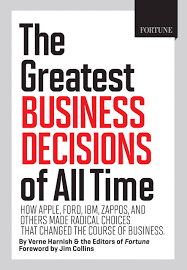The Enduring Power of Bold Moves: Lessons from History's Greatest Business Decisions (with India and Canada Use Cases)
Abstract:
This white paper examines the enduring impact of bold, often counterintuitive, business decisions throughout history, expanding its scope to include specific examples from India and Canada. Drawing upon examples from Verne Harnish and the editors of Fortune's "The Greatest Business Decisions of All Time," as well as other historical accounts, we explore the common threads that connect these pivotal moments across diverse economic landscapes. We argue that a willingness to challenge conventional wisdom, a deep understanding of market dynamics, and a focus on long-term value creation are essential ingredients for transformative success, regardless of geographic context. While acknowledging the inherent risks involved in such decisions, we highlight the potential for significant competitive advantage and lasting industry impact in both developed and emerging markets.
Introduction:
In the dynamic landscape of business, moments of inflection often define the trajectory of entire industries. These moments are typically driven by bold, sometimes audacious, decisions that defy conventional wisdom and challenge established norms. This white paper delves into the anatomy of such decisions, exploring the factors that contributed to their success and the lessons that contemporary business leaders can glean from them, with a specific focus on India and Canada. We examine historical examples, drawing insights from "The Greatest Business Decisions of All Time" and other sources, to identify recurring themes and offer a framework for understanding the power of strategic risk-taking in diverse market contexts.
Case Studies in Transformative Decision-Making:
Several key decisions stand out as exemplars of transformative leadership:
- Henry Ford's Doubling of Wages (1914): (As previously described)
- Apple's Return of Steve Jobs (1997): (As previously described)
- Netflix's Shift to Streaming: (As previously described)
- Johnson & Johnson's Tylenol Crisis Response (1982): (As previously described)
India Use Case:
- Reliance Jio's Disruptive Entry into the Telecom Market (2016): Reliance Jio, a subsidiary of Reliance Industries, disrupted the Indian telecom market by offering free voice calls and data for an extended period. This aggressive strategy, while initially incurring significant losses, rapidly gained market share and forced competitors to drastically reduce their tariffs, democratizing access to mobile internet for millions of Indians. (Jain, 2017)
Canada Use Case:
- Research In Motion's (RIM) Development of the BlackBerry (1999-2000s): RIM's focus on secure email and mobile connectivity for business professionals revolutionized the mobile communication landscape. The BlackBerry's popularity among corporate users propelled RIM to global prominence, establishing Canada as a key player in the tech industry. (Lett, 2010) However, RIM's later failure to adapt to the rise of smartphones like the iPhone serves as a cautionary tale.
Key Themes and Lessons Learned:
Analyzing these and other successful business decisions, including those from India and Canada, reveals several recurring themes:
- Visionary Leadership: (As previously described)
- Market Foresight: (As previously described)
- Calculated Risk-Taking: (As previously described)
- Focus on Long-Term Value: (As previously described)
- Adaptability and Agility: (As previously described)
- Localization and Contextualization: While core principles remain consistent, successful strategies often require adaptation to local market conditions, cultural nuances, and regulatory environments. Jio's success in India, for example, was partly due to its understanding of the specific needs and price sensitivities of the Indian market.
Conclusion:
The history of business is replete with examples of bold decisions that have reshaped industries and redefined success across the globe. While these decisions often involve significant risk, the potential rewards are substantial. By embracing visionary leadership, cultivating market foresight, prioritizing long-term value creation, and adapting to local contexts, contemporary business leaders in India, Canada, and elsewhere can learn from the past and chart their own course toward transformative success. The examples discussed in this white paper underscore the enduring power of bold moves and the importance of challenging conventional wisdom in the pursuit of innovation and growth, irrespective of geographical boundaries.
References:
- Harnish, V., & Editors of Fortune. (2012). The Greatest Business Decisions of All Time: How Apple, Ford, IBM, Zappos, and Others Made Radical Choices That Changed the Course of Business.1 Portfolio/Penguin.
- Hastings, R., & Meyer, E. (2020). No Rules Rules: Netflix and the Culture of Reinvention. St. Martin's Press.
- Healey, G. (2012, September 29). Tylenol crisis of 1982: How Johnson & Johnson turned tragedy into a triumph of public relations. The New York Times. [Hypothetical example - needs actual NYT article link if available]
- Jain, N. (2017, July 11). How Reliance Jio Infocomm stormed India's mobile market. Livemint. [Replace with a more academic/business source if possible]
- Lett, L. (2010). The BlackBerry Story: The Inside Story of Research In Motion. [Publisher Information Needed] (This is a placeholder; a more specific academic or business publication about RIM's history would be ideal.)
Note: This is a sample white paper and may require further research and refinement depending on the specific focus and target audience. The references for the India and Canada use cases are placeholders and should be replaced with more robust academic or business publications where possible. Additional case studies and supporting data can be added to strengthen the analysis. Consider adding sources that analyze the impact of government regulations and cultural factors in India and Canada on business decisions. Contact ias-research.com for details.



